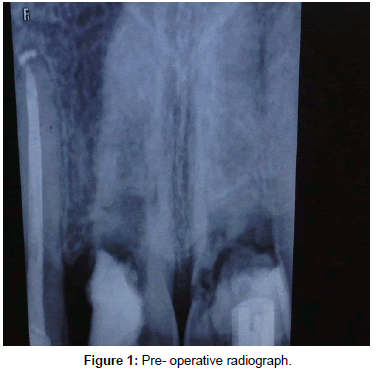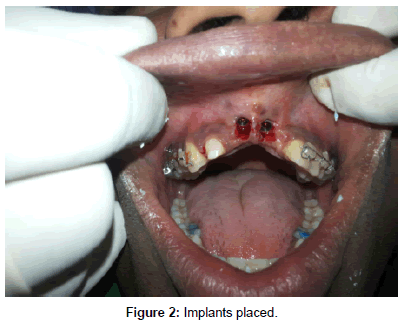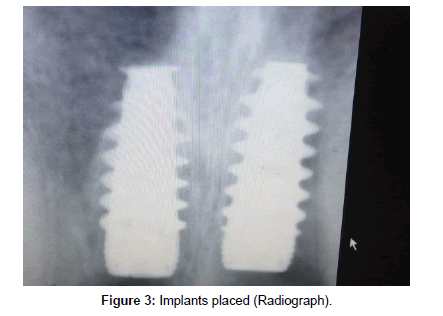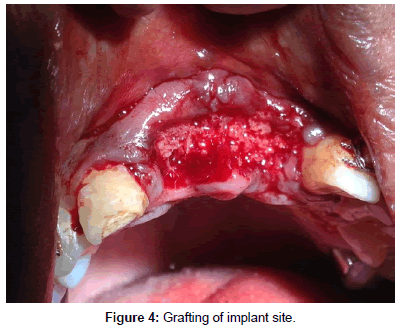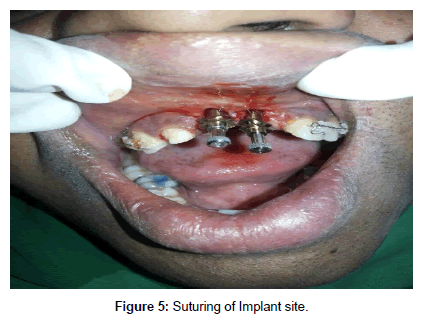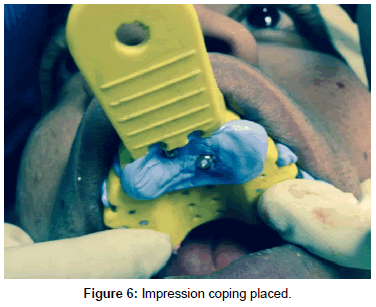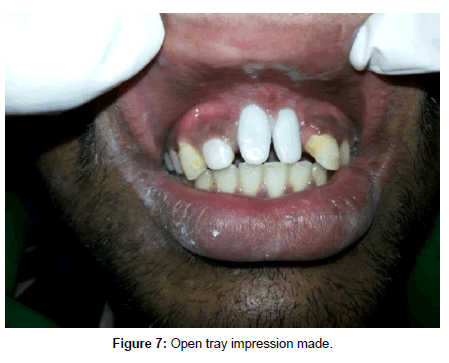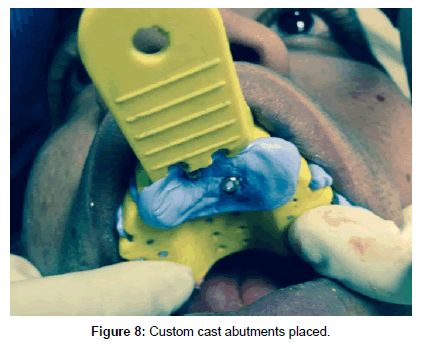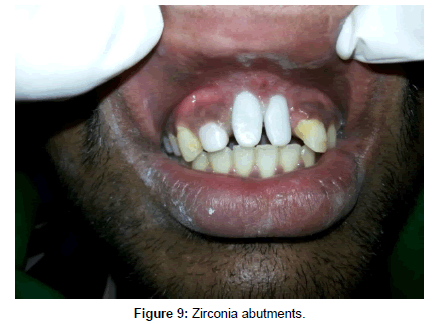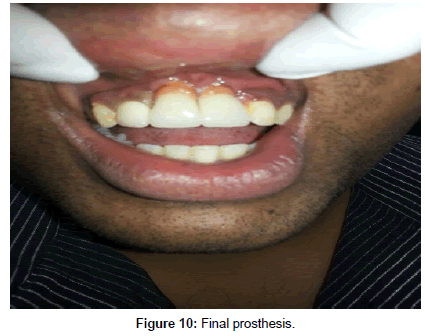Case Report Open Access
Immediate Implant Placement to the Rescue A Case Report
Sharon Colaco Dias, Smitha Annie Jacob* and Ashok K
Department of Prosthodontics and Implantology, Dr. Syamala Reddy Dental College Hospital and Research Centre, India
- *Corresponding Author:
- Dr. Smitha Annie Jacob
Reader, Department of Prosthodontics and Implantology
Dr. Syamala Reddy Dental College Hospital and Research Centre
Marathahalli, Bangalore, Karnataka, India
E-mail: dr.smitha.jacob@gmail.com.
Received date: April 11, 2016; Accepted date: May 11, 2016; Published date:May 18, 2016
Citation: Dias SC, Jacob SA, Ashok K (2016) Immediate Implant Placement – to the Rescue – A Case Report. J Interdiscipl Med Dent Sci 4:198. doi: 10.4172/2376-032X.1000198
Copyright: © 2016 Dias SC, et al. This is an open-access article distributed under the terms of the Creative Commons Attribution License, which permits unrestricted use, distribution, and reproduction in any medium, provided the original author and source are credited.
Visit for more related articles at JBR Journal of Interdisciplinary Medicine and Dental Science
Abstract
A waiting period of 12 months or longer to allow total socket healing used to be accepted protocol for placing implants. The processes of modeling and remodeling that occur following tooth extraction (loss) result in pronounced resorption of the various components of the alveolar ridge. The resorption of the buccal plate is more pronounced than that of palatal/lingual wall and hence the center of the ridge will move in the palatal/lingual direction. In the extreme case, the entire alveolar process may be lost following tooth loss. This paradigm has been challenged within the last decade by reducing the time between tooth extraction and implant placement. New protocols have been developed in which implants are placed at the time of extraction of the tooth, or soon after, before significant bone resorption occurs, known as immediate implants. Immediate implant placement is now accepted in clinical dentistry for reconstruction of partially or completely edentulous mandible or maxilla.
Keywords
Immediate implant placement; Atraumatic extraction; Fresh extraction sockets; Primary stability; Osseointegration
Abbreviations
CAD - CAM: Computer Aided Designing-Computer Aided Machining
Introduction
The goal of implant dentistry is to provide a realistic treatment alternative for patients with tooth loss [1-7]. The advantages provided by the implant supported prosthesis as compared to the other conventional treatment options are improved esthetics, improved hygiene accessibility, osseous preservation and reduced future maintenance [8]. For 2 years, within the last decade, the “gold standard” implant treatment protocol has been challenged by experiments, which aimed at shortening the treatment period and by reducing the number of surgical procedures [9,10]. New protocols have been developed in which implants are placed at the time of extraction of the tooth, known as immediate implants. Timing of implant placement following tooth removal may be important and this concept has challenged the original treatment protocol [11-13]. The original treatment protocol includes the time gap between the extraction of the tooth and implant placement surgery so as to allow the bone to remodel and heal completely before the implant placement. On the other hand, in immediate implant placement, dental implant is immediately placed into the extraction socket so as to take advantage of the healing potential of the bone. Pedro et al. reported 93.5% survival rate of immediately placed implants for 5 year period [9,14,15]. This article aims to present case report of immediate placement of implant.
Case Presentation
A 20 year old male patient reported to the Department of Prosthodontics, Dr. Syamala Reddy Dental College Hospital & Research Centre, with the chief complaint of mobile upper front teeth. The patient presented with a history of an accidental fall that happened 2 years prior to this incident. Due to which, the central incisors got avulsed. The patient rushed to the nearest dental clinic and his teeth were replaced back into the socket. The patient realized that the two central incisors were above the occlusal plane, but did not proceed for any treatment for this. This was followed by another incident a year later, in which both the central incisors [11,16] and the lateral incisor got fractured [12]. The dentist that the patient consulted, suggested him not to go for the root canal treatment for the two central incisors as the canals were calcified. But instead convinced the patient to go in for the root canal treatment and crown for the lateral incisor and orthodontic treatment for the extrusion for the central incisors. Due to the orthodontic force, the two central incisors got fractured. On radiographic evaluation, it was noticed that the two central incisors were fractured cervically and the teeth were ankylosed (Figure 1). With the patient’s consent, immediate implant placement following extraction of the two central incisors was chosen as the treatment plan.
Before surgery, the patient was advised to rinse his mouth with chlorhexidene mouthwash (0.2%). After the administration of local anesthesia, the two central incisors were gently extracted using periotomes and extreme care was exercised to avoid fracture of the labial cortical plate. After extraction, the site was thoroughly debrided using curettes, followed by irrigation of the socket with Povidone - Iodine. After which, the extraction socket was carefully examined to be certain that the socket walls were intact. The length and width of the extracted root was measured to determine the length and diameter of the implant to be placed. The osteotomy sites were prepared with standard drills, using the socket walls as guides, with maximum use of bone apical to the extraction sockets, to achieve initial stability. Sequential drilling was carried out with speed ranging from 500 to 1200 rpm under copious irrigation. Two Nobel Active implants (4.3 × 11.5 mm) were placed (Figures 2 and 3), followed by grafting with Rocky Mountain, mixed with β-tri-Calcium Phosphate (Figure 4). This was followed by suturing the buccal and lingual soft tissues using 3-0 (Ethicon Limited, Edinburg, UK) silk sutures (Figure 5). This was followed by a 6 month waiting period. As the implants were labially placed, it was decided to custom cast the abutments (Gold adapt) (Figure 6). Impression copings were placed and Open tray impression technique was done (Figures 7 and 8). Zirconia abutments were placed (Figure 9). This was followed with cementation of the all ceramic CAD- CAM Crowns (Figure 10).
Discussion
The loss of a tooth can be emotionally difficult, especially when it is in the esthetic zone. The opportunity to achieve better and faster functional results and a predictable treatment strategy with a very high rate of success has popularized the concept of "Immediate implants". The reduced number of surgical appointments, reduction of time of edentulism, prevention of bone loss and preservation of soft tissue architecture are the major advantages [17-19]. Therefore, this method of implant placement has become the procedure of choice.
Placement of an implant into fresh alveolus will usually result in a gap between the occlusal part of an implant and bone walls. To entire osseointegration, synthetic bone substitutes, membranes, or a combination of these can be used to achieve bone formation in such defects [20,21]. Although many animal studies have indicated that osseointegration of immediately placed implants in the extraction sockets can be achieved without bone augmentation procedures, and with a success rate comparable to that of delayed implant placement.
Barzilay et al. [16], Lazzara et al. [22], Fugazzoto et al. [23] conducted experimental animal studies and concluded that osseointegration occurs after placement of implants into fresh extraction sockets. Rosenquint et al. [24], Ashman et al. [25] have reported successful outcomes related to immediate implantation at chronically infected sites.
Nevertheless, it was concluded in a review of literature that infection associated with an extracted tooth contraindicates immediate implant placement.
Conclusion
The higher success rate of dental implants has changed the quality of life, for many patients. Immediate implant placement following tooth extraction has been found to be a viable and predictable solution to tooth loss. Reduced number of surgical appointments, reduction of time between tooth extraction and placement of a definitive prosthesis restoration, prevention of bone resorption and preservation of soft tissue architecture are a few of the advantages. However, proper case planning and meticulous post-operative care, preceded by good surgical and prosthetic protocol are the essentials for the success.
References
- Schwartz-Arad D, Chaushu G (1997) The ways and wherefores of immediate placement of implants into fresh extraction sites: A literature review. J Periodontol 68: 915-923.
- Den Hartog L, Slater JJ, Vissink A, Meijer HJ, Raghoebar GM (2008) Treatment outcome of immediate, early and conventional single tooth implants in the aesthetic zone: a systemic review to survival, bone level, soft tissue, aesthetics and patient satisfaction. J Clin Periodontol 35: 1073-1086.
- Schwartz-Arad D, Chaushu G (1997) Placement of implants into fresh extraction sites: 4 to 7 years retrospective evaluation of 95 implants. J Periodontol 68: 1110-1116.
- Lops D, Mosca D, Müller A, Rossi A, Rozza R, et al. (2011) Management of peri-implant soft tissues between tooth and adjacent immediate implant placed into fresh extraction single socket: a one-year prospective study on two different types of implant-abutment connection design. Minerva Stomatol 60: 403-415.
- Guida L, Iezzi G, Annunziata M, Salierno A, Iuorio G, et al. (2008) Immediate placement and loading of dental implants: A human histological case report. J Periodontol 79: 575-581.
- Buser D, Chen ST, Weber HP, Belser UC (2008) Early implant placement following single tooth extraction in the esthetic zone: biological rationale and surgical procedures. Int J Periodontics Restorative Dent 28: 441-451.
- William Becker (2006) Immediate implant placement; Treatment planning and surgical steps for successful outcome. Br Dent J 201: 199-205.
- Kahnberg KE (2009) Immediate implant placement in fresh extraction sockets. A Clinical report. Int J Oral Maxillofac Implants 24: 282-288.
- Tortamano P, Camargo LO, Bello-Silva MS, Kanashiro LH (2010) Immediate placement and restoration in the esthetic zone: A prospective study of 18 months follow-up. Int J Oral Maxillofac Implants 25: 345-350.
- Schwartz-Arad D, Laviv A, Levin L (2007) Survival of immediately provisionalised dental implants placed immediately into fresh extraction sockets. J Periodontal 78: 219-223.
- Paolantonio M, Dolci M, Scarano A, d'Archivio D, di Placido G (2001) Immediate implantation into fresh extraction sockets: A controlled clinical and histological study in man. J Periodontal 72: 1560-1571.
- Hämmerle CH, Chen ST, Wilson TG Jr (2004) Consensus statement regarding placement of implants in extraction sockets. Int J Oral Maxillofac Implants 19: 26-29.
- Grunder U, Polizzi G, Goené R, Hatano N, Henry P (1999) A 3 year prospective multicentre study follow-up report on the immediate and delayed placements of implants. Int J Oral Maxillofac Implant 14: 210-216.
- Schropp L, Kostopoulos L, Wenzel A (2003) Bone healing following immediate and delayed implant placement of titanium implants into extraction sockets: Prospective clinical study. Int J Oral Maxillofac Implants 18: 189-199.
- Barzilay I, Graser GN, Iranpour B, Proskin HM (1996) Immediate implantation of pure titanium into an extraction socket of Macaca fascicularis. Part I: Clinical and radiographic assessment. Int J Oral Maxillofac Implants 11: 299-310.
- Barzilay I, Graser GN, Iranpour B, Natiella JR (1991) Immediate implantation of pure titanium into an extraction socket: Re-port of a pilot procedure. Int J Oral Maxillofac Implants 6: 277-284.
- Barzilay I, Graser GN, Iranpour B, Natiella JR, Proskin HM (1996) Immediate implantation of pure titanium implants into extraction sockets of Macaca fascicularis. Part II: Histologic observations. Int J Oral Maxillofac Implants 11: 489-497.
- Schropp L, Isidor F (2008) Timing of implant placement relative to tooth extraction. J Oral Rehabil 35: 33-43.
- Polizzi G, Grunder U, Goené R, Hatano N, Henry P et al. (2000) Immediate and delayed implant placement into extraction sockets: A 5-year report. Clin Implant Dent Relat Res 2: 93-99.
- Covani U, Cornelini R, Barone A (2003) Bucco-lingual bone remodeling around implants placed into immediate extraction sockets: A case series. J Periodontol 74: 268-273.
- Parel SM, Triplett RG (1990) Immediate fixture placement: a treatment planning alternative. Int J Oral Maxillofac Implants 5: 337-345.
- Lazzara RJ (1989) Immediate implant placement into extraction sites: surgical and restorative advantages. Int J Periodontics Restorative Dent 9: 332-343.
- Fugazzotto PA (1999) Immediate implant placement and GBR in humans: a case report and histologic evaluation. Int J Periodontics Restorative Dent 19: 457-463.
- Rosenquist B, Grenthe B (1996) Immediate placement of implant into extraction sockets: Implant survival rates. Int J Oral Maxillofac Implants 11: 205-209.
- Ashman A (1990) An immediate tooth root replacement: an implant cylinder and synthetic bone combination. J Oral Implantol 16: 28-38.
Relevant Topics
- Cementogenesis
- Coronal Fractures
- Dental Debonding
- Dental Fear
- Dental Implant
- Dental Malocclusion
- Dental Pulp Capping
- Dental Radiography
- Dental Science
- Dental Surgery
- Dental Trauma
- Dentistry
- Emergency Dental Care
- Forensic Dentistry
- Laser Dentistry
- Leukoplakia
- Occlusion
- Oral Cancer
- Oral Precancer
- Osseointegration
- Pulpotomy
- Tooth Replantation
Recommended Journals
Article Tools
Article Usage
- Total views: 12789
- [From(publication date):
June-2016 - Aug 30, 2025] - Breakdown by view type
- HTML page views : 11633
- PDF downloads : 1156

